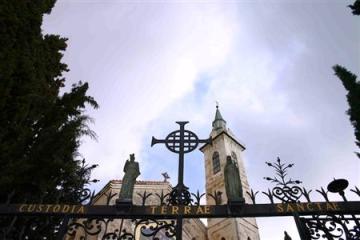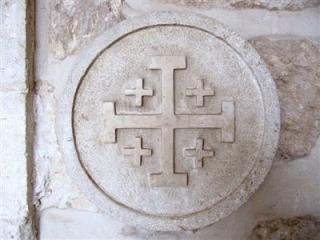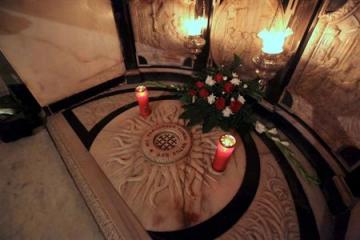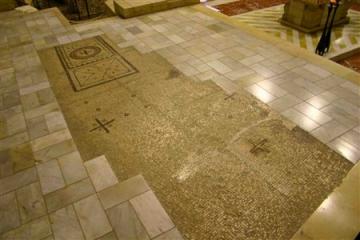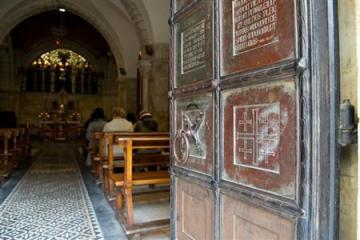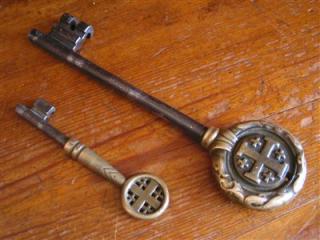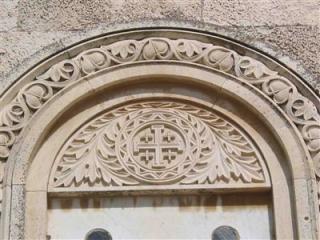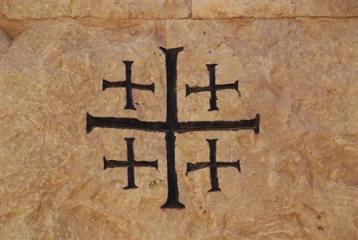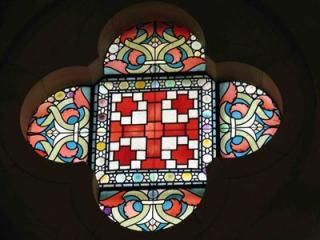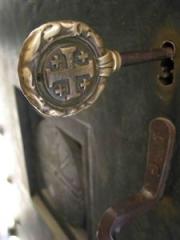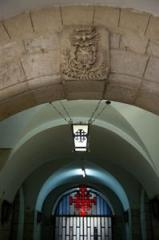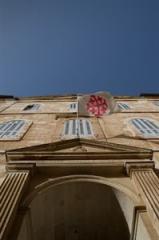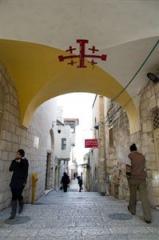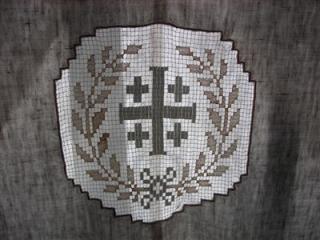
The Custody
We are a group of Christian men who have been called by God from every corner of the world for a special mission: to watch over His house
We belong to a religious Order in the Catholic Church, the Order of Friars Minor, the Franciscans.
Drawn by love of the poor and crucified Christ, our founder, Saint Francis of Assisi, went to the Middle East at the beginning of the 13th century, in order to “touch” the places which, up to our day, offer an irreplaceable testimony to God’s revelation and to God’s love for the human person. During his pilgrimage, and despite the Crusades, Saint Francis encountered and dialogued with the sultan Melek al-Kamel, who was governing the Holy Land at the time. It was a peaceful encounter, which marked the beginning of the Franciscans’ presence in the Holy Land and also influenced the way in which we have been present in the course of the centuries until today.
Over the course of time, this province of the Franciscan Order took the name “Custody of the Holy Land”.
The Franciscan Mission in the Holy Land
The friars have not only been the “guardians” of the stones and of those places in order to preserve their value, but their mission has also been to make them living stones, so that they speak to the heart and to the mind of all those who set off on a pilgrimage in the Holy Land, to be able to see the “simple stones” as “beloved stones” through their faith.
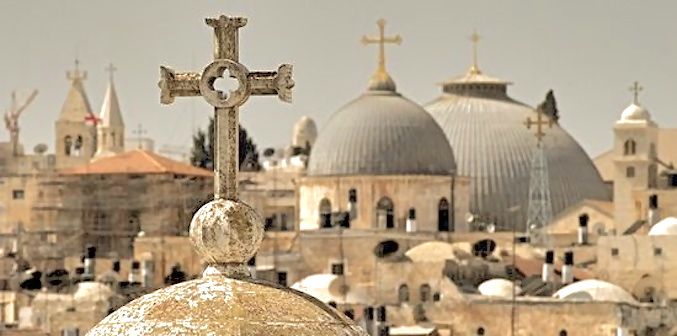
Saint Francis and the Franciscans always had at heart the love of the Incarnation of Jesus, and that is why they have loved the Holy Land since the beginning. For there is no Incarnation without a place. For us, loving this land means to love Jesus. And we cannot think of Jesus without loving His land. Because of the Franciscans’ special attachment to the Gospel of Jesus and to his Incarnation, our Catholic Church entrusted to us the mission of preserving the places of our salvation.
The Holy Places, however much their beauty can be admired, are not just stones.
They are the manifestation, the footprints of the passage of God in this world and the echo of the words of the Lord who spoke to us through prophets and apostles and became “flesh”, a man like us, living in our midst. They are stones which heard the words and drank the blood of our Saviour. That word of God and that blood that was spilt now have to be collected and preserved because they are part of the life of every Christian.
Listening to the voice that springs from those stones and understanding their message has always been the work of the sons of St. Francis in the Holy Land.
This is what the various Popes mean, when they say that the friars’ mission has been to work so that the Biblical Places become centres of spirituality, each sanctuary preserving and handing on the evangelical message and also nurturing the piety of the faithful.
To conclude: We are a fraternity of the Order of Friars Minor living in the Holy Land, who preserve, study and render the places where the Christian faith originated welcoming and proclaim the marvels of the love of the Most High Almighty and Good Lord who for our sake took on our humanity for the salvation of all people.
History of the Custody
Leading figures in the holy places, the Friars Minor fulfill their mission in this land encouraged by their founder, St. Francis. The first friars arrived in the Holy Land in 1217. Since then, they have always accepted the challenges of the times to be able to transmit the Grace of the holy places to the whole of humanity and to share their lives with the “living stones”, the local Christian communities.
- Period of Foundation (1217 - 1342)
- Period of Organization (1342 - 1517)
- The Question of the Holy Places (1517 -1852)
- The "modern" period (1852 - 1980)
- The bull of Pope Clement VI
- Status Quo
- A 800 year history

The Custody of the Holy Land is usually traced back to the year 1217, when the first General Chapter of the Friars Minor was celebrated at St. Mary of the Angels, near Assisi. In an act of inspiration, Francis decided to send his Friars to all nations.
The world was, so to speak, divided into Franciscan "provinces," and the friars from Assisi went out to the four corners of the world. On that occasion, the Holy Land was not forgotten. The Holy Land appears among the eleven Mother Provinces of the Order. In the documents, it is designated by various names: Syria, Romania, or Ultramarina.
It included the Empire of Constantinople, Greece and the Greek Isles, Asia Minor, Antioch, Syria, Palestine, Cyprus, Egypt, and the rest of the Orient. The Province of the Holy Land, because of the vastness of the territory and the presence of the holy places, was always given special consideration.
From the very beginning, it was considered to be the most important "province" of the Order. Perhaps this is why it was entrusted to the care of Brother Elias, a prominent figure in the burgeoning fraternity due to his organizational talent and his culture and experience. It would be interesting to know the initiatives taken by Brother Elias to organize and consolidate this part of the Order, characterized by particular environmental problems and by the vastness of the territory.
His zeal, and the qualities that distinguished him as a leader must have driven him during the years of his mandate to lay the foundations of the Franciscan apostolate in all regions situated in the southeastern basin of the Mediterranean.
In 1219, St. Francis himself wanted to visit at least a part of the Province of the Holy Land. Well-known documents speak of the "Poor man of Assisi" among the Crusaders, below the walls of Damietta. His encounter with the Sultan of Egypt, Malik al-Kamel, nephew of Saladin the Great, is also well documented.
The same documents add that after leaving Damietta, Francis went to Syria. In any case, the visit of St. Francis to the holy places certainly took place between 1219 and 1220. In this regard, Jacques de Vitry, bishop of Acre, wrote: "We saw the arrival of the friar Francis, founder of the Order of Friars Minor. He was a simple and unlettered man, but most lovable and dear to God and to men. He arrived when the army of the Crusaders was encamped below Damietta; he was immediately respected by all." During his brief voyage, Saint Francis showed by his own demeanour how future Franciscan missionaries should conduct themselves in those regions, and the specific field of their activity. According to the technique of the Poverello, evangelization must be done in a friendly way and with extreme humility, exactly as he had done with regard to the Sultan. Also, the holy places must be loved and venerated for their relationship with the most salient moments of the life of Christ.

Historians have argued that after the 13th century, and especially after the failure of the Crusades, access to the holy places was guaranteed using a new strategy, and that the missionary apostolate, with the unarmed presence of the Franciscans, replaced military expeditions. When Pope Gregory IX, then residing in Perugia, sent a Bull dated February 1, 1230, urging the Patriarchs of Antioch and Jerusalem, the legates of the Holy See, all the archbishops and bishops, abbots, priors, superiors, deacons and archdeacons and all the other prelates of the Church who received the Bull to welcome and support in any way possible the Order of Friars Minor, he must have intuited somehow that the Crusades had fallen short of their goal and that it would be better and above all more evangelical to try to coexist and dialogue with the Muslims instead of fighting them.
This would also further the cause of the holy places. Even if the 1230 Bull of Gregory IX cannot be considered an official document for the juridical recognition of the installation of the sons of Saint Francis in the Holy Land, it was nonetheless the document that paved the way for and enabled them to come to the country and settle there.
Another certain date in the history of the Province of the Holy Land is 1263. That year, under the generalship of St. Bonaventure, the General Chapter was convened in Pisa. On that occasion, naturally, the Province of the Holy Land was also discussed. Its boundaries were set to include the Island of Cyprus, Syria, Lebanon, and Palestine, dividing it into Custodies, including that of the Holy Land, which included the convents of Saint Jean d'Acre, Antioch, Sidon, Tripoli, Jerusalem and Jaffa.
The reconquest of Acre by the Muslims on May 18, 1291, marked the end of the Latin kingdom in the Holy Land. The Christians were put to severe hardship. The Franciscans were expelled from the Holy Land and forced to take refuge in Cyprus where, at the time, the Provincial headquarters was located.
From the nearby island of Cyprus, the Franciscans never lost interest in the Holy Land. Like exiles far from their country, their constant desire was to find the means to live near the holy places. Nothing was overlooked in the pursuit of this goal. Historical documents of the time testified to private devotional visits and visits authorized by the Holy See in order to restore the Catholic presence in the holy places. A first benevolent gesture on behalf of the Franciscans was made by Sultan Baibars II (1309-10), who gave them the "Church of Bethlehem", but the Sultan died soon afterward, and the friars were unable to take possession of it.
In 1322, James II of Aragon obtained an agreement from the Sultan of Egypt, Malik al-Kamel Naser, whereby the custody of the Holy Sepulcher would be entrusted to Aragonese Dominicans. This promise remained only in writing. Four years later, in 1327, James II again appealed to the sovereign grace, this time not for the Dominicans but for the Friars Minor.
The Bull of Pope John XXII, released on August 9, 1328, which granted the Provincial Minister living in Cyprus permission to send two friars to visit the holy places each year, must be interpreted in this vein. Even here, everyday practice preceded the organizational plan from the top. In fact, there were already Franciscans serving at the Holy Sepulcher between 1322 and 1327. In 1333, the Sultan of Egypt granted the Cenacle to Friar Roger Guérin of Aquitaine. He hastened to build a convent in the immediate vicinity, with funds made available by the Sovereigns of Naples, Roberto d'Angiò and by his wife, Sancha, daughter of James I, king of Majorca. These two sovereigns are rightly considered "instruments of Providence" for the cause of the holy places: they played key roles for their recovery; both by their diplomatic influence and through the financial help they gave. It was thanks to them and their intercession that the local Muslim authorities recognized the official right of the Franciscans to officiate in the Basilica of the Holy Sepulcher.

Juridical recognition on the part of the Holy See, which was also extended to the other shrines, came a few years later, specifically on November 21, 1342, with the Bulls Gratias agimus and Nuper carissimae. This is considered the definitive conclusion of the involvement of the Kings of Naples in the long negotiations for the cause of the holy places. In addition to official recognition, the Bull contained provisions to ensure the continuity of the institution.
With special insight, the international scope of the new ecclesiastical and religious body was assured, prescribing that the friars could come from any of the provinces of the order. For the protection of discipline, it required that all friars, once they entered into service in the Holy Land, be under the obedience of the Father Guardian of Mount Zion in Jerusalem, the representative of the Provincial Minister residing in Cyprus.
In 1347, the Franciscans settled permanently in Bethlehem near the Basilica of the Nativity of our Lord.
The first statutes of the Holy Land, which date back to 1377, provided for no more than twenty religious at the service of the holy places: the Holy Cenacle, the Holy Sepulcher, and Bethlehem. Their main activity consisted of ensuring the liturgical life in the shrines mentioned, and in providing religious assistance for European pilgrims. A document from 1390, specifies that the Province of the Holy Land, with its headquarters in Cyprus, also had a Custody in Syria, including four convents: Mount Zion, the Holy Sepulcher, Bethlehem, and Beirut.
Note that the document in question does nothing other than confirm what was already a pre-existing situation, both in the number of convents and of the name of the religious body called the Custody of Syria, perhaps to avoid confusion with the name of the Province of the Holy Land, to which it belonged.
In this first official period of its history, the Custody received the "seal of martyrdom" with the sacrifice of a number of its friars. Franciscan blood first bathed the ground of Jerusalem in 1244, during the siege of the Khwarezmians, who put many Christians to the sword and brutally slaughtered the Friars Minor. Others, commemorated by Alexander IV, underwent martyrdom in 1257.
Nine years later, in Safed in 1266, more than two thousand Christian combatants died after the occupation of the city by Sultan Bibars. The heroic friars who would not renounce their faith also died with them. In 1268, Jaffa and Antioch also had their Franciscan victims. Again in Syria, in 1269, eight friars fell beneath the Saracen sword. The story is told how two brilliant lights shone over the body of one of them, Friar Corrado de Hallis, floating on the waves of the sea for almost three days. In Damascus and Tripoli, in 1277, new Christian blood was spilled by the soldiers of Sultan Kelaun. Acre, the last bastion of the Latin Kingdom, was besieged by Sultan Melek el Ascaraf. More than thirty thousand Christians and many friars fell at the hands of the Saracens.

In order to bring together the mandate and legacy of the Crusades, the Province of the Holy Land had embarked upon the specific conquest of the holy places and was designated to represent the interests of the Catholic Church in the Middle East. Its juridical existence was recognized by both ecclesiastical and Muslim civil authorities.
In 1347, Franciscans established themselves as the officiates at the Basilica of the Grotto of the Nativity. In 1363, Giovanna, Queen of Naples and Sicily, obtained a firman (or edict) from the sultan of Egypt. By virtue of this firman, the Franciscans entered into possession of the Basilica and of the Tomb of the Virgin in the Valley of Josaphat. In 1375, from the convent of Bethlehem, the Franciscans also began working at the "Milk Grotto", situated near the Grotto of the Nativity of the Lord. In 1392, they obtained the right to officiate at the Grotto of Gethsemane, situated in the valley of Josaphat, a few meters from the Tomb of the Virgin, and in 1485, they readapted the Grotto of the Birth of St. John the Baptist in Ein Karem for worship.
With the increase of activity, the need was felt for adequate legislation. In 1377, the first Statutes of the Holy Land were approved. It developed the first prescriptions, briefly summarized in the Bull Gratias agimus, requiring that the number of religious serving in the Holy Land should not exceed twenty. As for their activities, in addition to taking care of religious worship in the shrines, the friars also had to provide for the European pilgrims who visited the holy places.
In 1414, the General Chapter of the Friars Minor was held in Lausanne. The Chapter, as in the previous General Assemblies, discussed the problems of the Holy Land, and realized that it was necessary to make this Custody more autonomous from the Province and increase the number of religious serving there. Sixteen years later, in 1430, it was established that the Custos of the Holy Land be elected by the General Chapter, a practice maintained for three centuries. Later, the Custos of the Holy Land was chosen by the Minister General and by his Council, a custom that has continued until today.
In 1517, the Custody of the Holy Land, while still retaining its title, gained complete autonomy through its configuration as a Province, characterized as always by entirely special privileges. In conjunction with the progressive delineation of its juridical form, the Custody received particular faculties and authorizations in various areas from the Holy See, always with a view to a more dynamic presence of the Franciscans in the Holy Land. This meant that the friars were able to work more effectively, especially in the spiritual assistance of the pilgrims, and more so in ecumenical activity.
This had its first crowning achievement during the Council of Florence (1431-1443), in which reconciliation was reached between the separated Christians of the East and the Catholic Church. This reconciliation soon showed itself to be ephemeral, and for almost two centuries the Franciscans of the Holy Land represented virtually the only possibility "on the ground" for direct and authorized relations between the Catholic world and the separated Churches of the Near and Middle East. Relations with the Eastern Churches continued, even until today, adapting to the different times and situations, coupled with a number of other initiatives undertaken by the Holy See in order to revive contacts and the ecumenical spirit.
Although this special apostolate has been adequately researched, unfortunately it is not as well known as it deserves. Another relatively unknown activity in the historiography of the Franciscans in the Holy Land is that of spiritual assistance for the European merchants living in or passing through the main cities of Egypt, Syria and Lebanon, that developed mainly in the fifteenth century and afterward. In the second half of the sixteenth century, spiritual assistance progressed from being a seasonal activity, especially during Advent and Lent, to a more or less continuous one, until it took on a stable character in the seventeenth century with the establishment of fixed residences. The Franciscans, who first began as chaplains of the European Consuls of merchant colonies, remained as apostles at the service of all, "radiating the light of the Gospel" around their residences, which, little by little, took on the form of proper parishes with related works of various kinds.
The evangelization of the Holy Land, during particular historical periods, was also directed toward the faithful of the Muslim religion, in the form of both personal and collective evangelization. These efforts always brought fleeting results, and also led to the death of some friars. In 1391, four friars were martyred. These martyrs were canonized by Paul VI on June 21, 1970: Nikola Tavelić (Croatian), Stefano da Cuneo (Italian), Deodatus of Rodez and Pierre of Narbonne (French). Speaking of these martyrs in the speech given on the occasion of their canonization, the Pope stated that "we are in the presence of a paradoxical witness, a shocking witness, a vain witness, because it was not accepted immediately, but is supremely valuable, because it is validated by the gift of self."
However, the presence of the Franciscans in the Holy Land was primarily linked to the shrines and their care because, ultimately, all other activities were connected to this purpose and were considered as primary and of exclusive importance for the entire Church.
From the beginning of this period, which we have call the Period of Organization, the Franciscans worked to repair the shrines of the Holy Land that had fallen into ruin over time. In 1343, the Holy Cenacle, build in the era of the Crusades, was repaired. In 1479, under the Guardianship of Fr. Giovanni Tomacelli da Napoli, all of the support beams for the ceiling of the Basilica of the Nativity in Bethlehem were replaced. The completion of the project involved the assistance of the Republic of Venice, who donated the wood needed, the Duke of Burgundy, Philip the Good, who paid for the work and King Edward IV of England, who donated the lead used for roofing.
There are not many events recorded in this period. It is necessary to note that positive results were the outcome of complex and seemingly endless negotiations, often economically burdensome and always faced with unyielding tenacity by the Order.
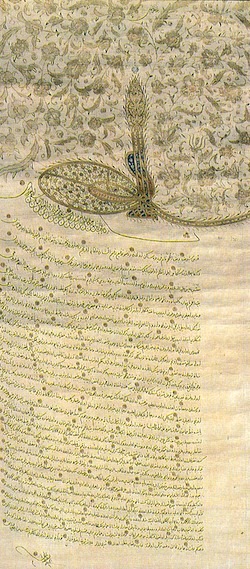
This was, without a doubt, the most difficult period in the age-old history of the Holy Land. Never as in this period of time has it been possible to verify the saying accorded to the Holy Land, "there is never July weather, it is always March," meaning that one cannot be sure of anything because everything can change in an instant the way the weather changes in the month of March.
It was a time of persecution: harassment, expulsion, exile and the stripping away of laboriously acquired rights were the order of the day. Over the previous three centuries, the Franciscans had established a substantial presence at the shrines. The Franciscan community had settled in and built a convent at Mount Zion, with exclusive rights to officiate at the Holy Cenacle, and officiated together with other Christian communities at the Holy Sepulcher, the Basilica of St. Mary in the Valley of Josaphat and the Nativity in Bethlehem. At the Holy Sepulcher during the 15th century, the Franciscans were in exclusive and peaceful possession of the building of the Sepulcher itself, of the Chapel of Calvary and of the Crypt of the finding of the Cross.
In 1517, Mamluk rule in Palestine was succeeded by that of the Turkish sultans based in Constantinople. The Greek Orthodox communities, taking advantage of the fact that their members were subjects of the Ottoman Empire, came streaming into the Holy Land.
Competition for the possession of the holy places led those communities to begin a defamation campaign against the Franciscans, depicting them as usurpers, foreigners, and enemies of the Turkish Empire. In that period, the Custody of the Holy Land underwent unjust usurpations.
The most humiliating and serious was definitive expulsion from the Holy Cenacle, which took place in 1552. It was a hard blow: the convent of Mount Zion had been, for two centuries, the heartbeat of Franciscan activity in the Holy Land.
Between the sixteenth and nineteenth centuries, the history of the holy places in regard to the right of legal possession saw a succession of losses and partial recuperations. If everything was not lost at the Basilicas of the Holy Sepulcher and the Nativity, this was due to the partial and laborious action undertaken by the heads of the Custody. They asked Catholic rulers to begin diplomatic work with the Muslim sultans of Constantinople for the defense of Catholic rights in the holy places.
Pope Urban VIII himself, with a bull issued in 1623, reaffirmed that it was the right and duty of all Catholic princes to protect the Franciscans of the Holy Land.
While losses of rights were experienced in the Basilicas of the Holy Sepulcher, the Nativity and the Tomb of the Virgin in the Valley of Josaphat, the Franciscans acquired new rights in other places.
In 1620, they took definitive possession of the site of the Annunciation in Nazareth, and were granted Mount Tabor. The two acquisitions were a result of the benevolence of the Druze Prince Fakhr-al-Din.
In 1684, the area of Gethsemane was acquired, and in 1679, that of the shrine of St. John in Ein Karem.
In 1754, the Shrine of the Nutrition in Nazareth was acquired, and in 1836, that of the Flagellation in Jerusalem.
Reviewing the history of the Custody from the 16th to the 19th century, note should be made of the variations that the Custody’s juridical profile underwent in ecclesiastical law - variations in practice corresponding to the evolution of the juridical figure of the Father Custos.
Dominican Fr. Felice Fabri, who was in the Holy Land in 1480, and again in 1483, presents the Father Custos of the Holy Land to us with the rank and title of "Provisor" for the Latin Church in the East, an office that, as he says, was frequently conferred by the Pope.
The first time that the Custody of the Holy Land was presented as "Responsale" by the Sacred Congregation for the Propagation of the Faith in almost the entire Middle East was in 1628. Later it became a regular “Institution.” Records also charge the Custos with the office of "Prefect of the Missions of Egypt and of Cyprus." Another important title and juridical attribute is that of "Apostolic Commissioner of the Holy Land and of the East." All of these duties remained the responsibility of the Father Custos until the reconstitution of the Latin Patriarchate of Jerusalem in 1847.
Naturally, the relationship between the Custody of the Holy Land and the Catholic West also had an economic aspect, as the Franciscan organization was not involved in capital investment and refrained from any possible gain in its areas of activity.
Thus it was necessary that the Custody needed to be externally financed. Over the centuries, the Popes reminded the entire Church through important documents of its duty to help the Holy Land, requiring periodic collections in all dioceses. Economic aid from European governments was also certainly providential, even if it was not always adequate in fulfilling the material needs and the needs of prestige, an important aspect in the Eastern culture in which the Custody operates.
In this respect, great assistance was provided to the Custody by the Kingdom of Naples through the creation of the Commissariat of Naples in the year 1621, through which funds that had been collected were sent to the Holy Land. Another Commissariat was created in 1636, in the Kingdom of Two Sicilies, based in Messina, followed by another in Palermo.
From the other end of Italy, Venice encouraged pilgrimages to the Holy Land by providing transport on its ships and the guarantee of a safe voyage. In 1593, it was even established that the Custos and those religious elected with him to govern the friars serving the Holy Places would set out for the East exclusively from Venice. In 1520, the Venetian Senate expressed a desire to become the advocate of the Guardian of Mount Zion, reminding the Pope that the Franciscan order had custody of the holy places, and asking him to confirm this privilege. Venice was also committed to the defense of the holy places through its diplomatic relations with Constantinople.
France's policy on the Custody of the Holy Land was expressed through Capitulations or contracts granted by the Ottoman Empire, which France received for the first time in 1535, from the Sultan of Constantinople, Suleiman II the Magnificent. When Suleiman was in full expansion toward Europe and elsewhere, King Francis I signed an alliance with him against Henry VIII of England, causing great scandal among the Christian kingdoms of Europe.
But the Capitulations nonetheless served as a bridge that allowed the Muslim states to enter into peaceful and friendly relations with the Christian world. For France, the Capitulations constituted a moral obligation to intervene and protect the Franciscans through the intermediation of its ambassadors in Constantinople, who intervened in moments of grave difficulty, especially in the 17th century. Later, the French consul resided in Seyde, traveling to Jerusalem to address unresolved questions. On these occasions liturgical honors were rendered. This situation lasted until 1793. The Capitulations disappeared definitively only in 1917, with the Allied occupation of Jerusalem, and were not legally abolished until 1923 with the Treaty of Lousanne.
The French Protectorate over all Catholics began with King Louis XIV, who wanted to be the defender of the Christians of the Ottoman Empire, although he only implicitly obtained this right and in rather ambiguous terms. It was only under King Louis XV, with the Capitulation of 1740, that the rights of the Protectorate of France were sanctioned and officially recognized, thanks to the role that the Protectorate played on behalf of the Ottoman Empire at the Treaty of Belgrade. The Holy See officially recognized the French Protectorate over all Catholics of every nationality within the Ottoman Empire, including Turks, the Ottoman Empire and those of the Eastern Rites. In 1870, France was alarmed by the appointment of the patriarchal vicar of Constantinople as apostolic delegate. The Protectorate was also prepared to intervene in the establishment of diplomatic relations between the Holy See and Turkey, but those under French protection who were not French citizens resented the arrangement. After the start of the twentieth century, more and more non-French religious lost the practice of using their respective consuls, so that the protection of the latter was added to that of France. The French Protectorate continued until 1923, and was abandoned at San Remo by representatives of France. The end point can be traced to the Lausanne Peace Treaty, signed between Turkey and the Entente Powers July 24, 1923. All that is left of this long tradition marked by diplomacy is the liturgical honors still granted by the Vatican to France in some of the countries once belonging to the Ottoman Empire.
From the beginning, Spain worked to help the Christians and friars in the Holy Land by sending large sums of money to the East. When the Kingdoms of Aragon and Castile were united, the Catholic monarchs assumed the responsibility of helping the Holy Land and the Franciscan guardians of the shrines, sending one thousand crowns each year for this purpose. In 1550, Charles V approved funds for the restoration of the Basilica of the Holy Sepulcher. In 1646, the Sacred Congregation issued a decree prohibiting the Franciscans of the Holy Land from using money to buy back shrines. The Spanish King then took direct action in the matter, sending a Spanish friar to the court of Constantinople, who, after eleven years, obtained the restitution of the rights of the Franciscans over the shrines that had been usurped by the Greeks.
In 1714, the Basilica of the Holy Sepulcher was restored, and again the Spanish King covered the cost of the project. An institution was established in Madrid for the "Pious Work of the Holy Places”, that administered aid to the Holy Land.
Charles III defended the rights of Spanish patronage over the holy places was with the Royal Bull of 1772, in response to the Bull of Pope Benedict IV In supremo, in which these rights were not mentioned. This royal decree was a stern warning to anyone who took an interest in the problems of the Holy Land. In order to defend their rights, the King forced Pope Pius VI to publish the Brief Inter multiplices in 1878, which confirmed the claims of Charles III, a document that he later withdrew because of the political situation in Spain. In 1846, with the Bull Romani pontifices, the Holy See reunified the case of Spain and that of the Nation into a single case in support of the Holy Land. In 1853, the Spanish Consulate in Jerusalem was created in order to protect religious Spaniards in the Holy Land and to administer money sent by the Attorney General of the Friars so that these funds did not fall into the hands of the Latin Patriarchate, which had been reconstituted in 1848. Pressured by Isabella II of Spain to send missionaries to the Holy Land, the “College of Priego” was founded in 1853, followed by those of Santiago de Compostela and Chipiona.
Also in this period, many friars of the Custody were victimized because of their faith. In 1530, friars were incarcerated because of the legend of the treasures collected in the Holy Sepulcher: the unfaithful tried to seize the treasures and, failing that, put the friars in prison for 27 months. Another persecution broke out in Palestine between 1537 and 1540, when Muslims took revenge for the defeat of 1537, imprisoning the friars of Mount Zion and Bethlehem in Damascus for 38 months. In 1551, the friars were expelled from Mount Zion, settling first in the Tower of the Furnace and later, in 1558, in St. Savior’s Convent. In 1548, a persecution broke out in Nazareth, causing the friars to flee to Jerusalem. The situation was repeated between 1632 and 1638. Other brothers died in the Holy Land because of the hatred of the Greeks, as was the case in 1560 on the Island of Candia, when two friars were thrown into the sea. The arrival of Napoleon in the Holy Land sparked persecutions in Jerusalem and Ramleh in 1799. The situation was escalated by a recurring plague in the eighteenth and nineteenth centuries.
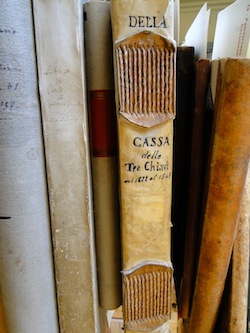
In 1847, Pope Pius IX, with the Apostolic Letter Nulla celebrior, re-established the Latin Patriarchate in Jerusalem. The document recalled the obstacles that had hitherto prevented the Latin Patriarch from residing in Jerusalem and restored the exercise of jurisdiction of the Latin Patriarch in Jerusalem. During this time, the Franciscans in the Holy Land continue to fulfill their providential mission to care for the holy places and to expand activities for the people in this area to whom they were missioned.
A number of shrines were acquired over the course of the years: In 1867, Servant of God Pauline Nicolay gave the Custody the shrine at Emmaus; in 1875, the 7th Station on the Via Dolorosa was acquired; in 1878, the shrine of Naim; in 1879, talks concluded over the shrine at Cana; in 1880, the shrine of Bethpage was acquired; between 1889-1950, the Custody acquired the right to take possession of the 5th Station, the "Dominus Flevit", Tabgha, Capernaum, the Shepherds' Field near Bethlehem, the Monastery of St. John the Baptist in the Desert, Mount Nebo, the place of Jesus' baptism on the banks of the Jordan, a small place in the immediate vicinity of the Holy Cenacle and Bethany.
During this period the Custody of the Holy Land played a role in the partial or total reconstruction of the shrines. These often consisted of small, unpretentious chapels. For economic reasons and those of social resistance, it was not possible to do more.
The Franciscans endeavored to maintain the shrines in a spirit of dignity and devotion proper to the needs of the faithful. A record of construction projects include the following: the Basilica of Emmaus in 1901; the Basilica of the Agony at Gethsemane between 1919-1924; the Basilica of the Transfiguration on Mount Tabor between 1921-1924; the new shrine at Bethany between 1952-1953; the Chapel at the Shepherds’ Field near Bethlehem between 1953-1954; the Church of "Dominus Flevit” on the slopes of the Mount of Olives in 1955; and the Basilica of the Annunciation in Nazareth between 1955-1969.
During this period, more friars’ blood was spilled. In 1860, persecutions arose against Christians by the Druze in Lebanon and in Syria. The persecutions were sparked by a decree signed by Sultan Abdul-Mejid in Paris in 1856, in which he recognized the equality of all his subjects, without distinction of race or religion. The persecutions led to about 7,000 deaths, among them Blessed Emmanuel Ruiz and his martyred companions. Another case of martyrdom took place in Turkey in 1895, when Friar Salvatore Lilli was killed. He who was later canonized.
The historical climate of the early Twentieth Century can be better understood by reading the chronicles of that period. In 1901, bloody attacks arose partially due to tensions concerning the status quo. On one occasion, Greek monks stoned friars over whose right it was to sweep the square next to the stairs that led to the so-called chapel of the Franks. In 1920, Turks killed three priests and two friars over tensions related to the persecution of the Armenians.
In conclusion, Pope Paul VI, in his Apostolic Exhortation Nobis in animo (1974), gave an historical overview of the Custody of the Holy Land: "Not without a providential plan have the historical events of the thirteenth century been brought to the Order of the Friars Minor in the Holy Land. The children of St. Francis have, since then, remained in the Land of Jesus for several consecutive years to serve the local Church and to preserve, restore, protect the Christian Holy Places; their loyalty to the desire of their founder and to the mandate of the Holy See was often sealed by acts of extraordinary virtue and generosity.”
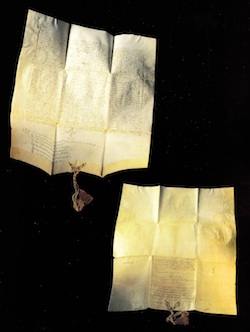
Juridical Constitution of the Custody of the Holy Land
Clement, bishop, servant of the servants of God, to his well-loved sons the Minister General and the Minister of the Land where the Order of Friars Minor labour, salutations and Apostolic Blessing.
1. We give thanks to the Dispenser of all good, offering Him worthy praise, for having awakened such zeal and fervour of devotion and faith in our most dear children in Christ, King Robert and Sanche, Queen of Sicily, illustrious in honouring our Redeemer and our Lord Jesus Christ, not ceasing to work with indefatigable love for the praise and glory of God, as well as for the veneration and honour of the Holy Sepulchre of the Lord and of the other Holy Places beyond the sea.
2. A short time ago good news from the king and queen reached our Apostolic See relating that, at great cost and following difficult negotiations, they had obtained a concession from the Sultan of Babylon (that is, Cairo), who to the intense shame of Christians occupies the Holy Sepulchre of the Lord and the other Holy Places beyond the sea that were sanctified by the blood of this same Redeemer, to wit that friars of your Order may reside continuously in the church known as the Sepulchre and celebrate there Solemn Sung Masses and the Divine Office in the manner of the several friars of this Order who are already present in this place; moreover, this same Sultan has also conceded to the King and Queen the Cenacle of the Lord, the chapel where the Holy Spirit was manifested to the Apostles and the other chapel in which Christ appeared to the Apostles after his resurrection, in the presence of Blessed Thomas; and also the news of how the Queen built a convent on Mount Zion where, as is known, the Cenacle and the said chapels are located; where for some time she has had the intention of supporting twelve friars of your Order to assure the divine Liturgy in the church of the Holy Sepulchre, along with three laymen charged with serving the friars and seeing to their needs.
3. To this end, the abovementioned Queen, in fulfilment of her pious devotion and that of the King, humbly asked us to intervene with our Apostolic Authority towards providing for the needs of these same Holy Places by sending devoted friars and qualified servants to the abovementioned number.
4. We, therefore, approving the pious and praiseworthy proposal of the said King and Queen, and their devout intention worthy of divine blessing, and wanting to favour and encourage their wishes and desires, by this present [bull] do concede to all and to each of you full and free power to summon, now and in the future, in your presence and by apostolic authority and at the request of the abovementioned King and Queen and their successors, after having heard the advice of the counsellors of your Order, capable and devout friars from among the entire Order to the number indicated.
5. Furthermore, considering the importance of this matter, due consideration is to be given to those friars who are destined to the service of God at the Holy Sepulchre, as well as at the Holy Cenacle and in the above-mentioned chapels; this, after duly inquiring of their Provincial Minister of your Order regarding the aptitudes of those friars designated and temporarily destined for these regions beyond the sea and, in the case of one of them being absent, that on each occasion required, the friars sent to replace those absent be given license to reside in these regions.
6. We further grant you, in case of refusal on the friars’ part, the power to oblige them to obey, following an admonition, through the use of ecclesiastical censures. Nothing is to contradict these provisions, not any apostolic prohibition or contradictory statutes of the Order, even if supported by solemn attestation or apostolic ratification or any other convention, nor yet if some have received from the Apostolic See, in general or in particular, exemption from interdiction, suspension or excommunication, unless the apostolic letter makes full, express and literal mention of this indult.
7. We desire that, when those friars so designated are present in the regions beyond the sea, they be under obedience to and subject to the governance of the Guardian of the friars of your Order, as well as the Minister Provincial of the Holy Land, with all that falls within his competence.
Given at Avignon the 21st of November, 1342, in the first year of Our Pontificate.
"Status quo" or “statu quo", as it is commonly called in the Holy Land and in many publications, in a broad sense refers to the relations between the Christian communities of the Holy Land with the governments of the region.
Specifically, status quo applies to the situation within the Holy Land in which the Christian communities find themselves regarding ownership and rights possessed by each within the sanctuaries, both alone and in conjunction with other rites within the Basilica of the Holy Sepulcher, the Basilica of the Nativity in Bethlehem and the Tomb of the Virgin Mary in Jerusalem.
The life of the sanctuaries is inseparable from the political regimes of the Holy Land, which have slowly led to the situation in force today. During the 17th and 18th centuries, the Greek Orthodox and Catholic Churches were in continual struggle over a number of sanctuaries, more specifically, the Holy Sepulcher, the Tomb of the Madonna and the Grotto of the Nativity in Bethlehem).
It was a period of “fraternal strife and political interventions”. Through these painful events, one arrived at the existing situation, ratified by an official declaration on February 8, 1852, and referred to by the term status quo. The status quo in the sanctuaries of the Holy Land, especially in the Holy Sepulcher, determine the subjects of ownership of the holy places, and more specifically, the spaces inside the sanctuaries. It also extends to the times and durations of functions, movements, the routes taken and how they are implemented, whether by singing or by reading.
It must be remembered that the officiating communities in the Holy Sepulcher, in addition to the Latin or Catholic community, are the Greek, Armenian, Coptic and Syrian communities, and that any change requires the consent of all the communities. The communities of the Holy Sepulcher are regulated according to the proper calendars of each rite.
For the Catholic community, the Franciscans follow the liturgical celebrations in accord with the level of solemnity established before the reform of Vatican II, as this entitles the community, as acquired by status quo, the right to solemn First Vespers, Matins, Mass and other functions related to the celebration, including processions, blessings with incense, etc.
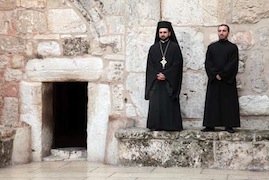
o better understand this situation, some historical outline is necessary.
In 1463, immediately after his entrance into Constantinople, Mohammed II proclaimed the Greek Patriarch of Constantinople the religious and civil authority for all Christians residing in his Empire.
From that time on, the Orthodox religious communities of Greece, availing themselves as subjects of the Ottoman Empire, were able to pour into the Holy Land and exercise a most effective influence over the sultan, obtaining advantages in their favour within the sanctuaries. Greek clerics were progressively able to replace the Oriental or native clerics.
Since 1634, the Orthodox Patriarch of Jerusalem has always been a native Greek.
In 1517, the Ottoman Empire gained control of Palestine from the Mamluks of Egypt. This started a definite change of “balance of power” in relation to the Christian holy places. During this century, Greek (Hellenic) clergy began to claim rights to the holy places. In 1666, the Orthodox Patriarch Germano claimed Orthodox rights over the Basilica of Bethlehem, confirming claims made by the Patriarchs Sofronius IV (1579-1608) and Theophanes (1608-1644). Similar claims were also made on the Holy Sepulcher in Jerusalem. Such attempts were stopped through the intervention of the Western powers of Venice and especially of France to the Sublime Porte (as was called the Supreme Chamber of the Ottoman Empire). In 1633, Patriarch Theophanius managed to obtain an official decree backdated to the time of Omar (638), which gave the Greek Orthodox Patriarch exclusive rights to the Grotto of the Nativity, Calvary and the Stone of Unction. The Western powers were able to obtain, under pressure by Pope Urban VII, the retraction of the decree. This decree, however, was issued again in 1637.
At that time, Venice, Austria and Poland were at war against the Empire, and they were unable to have any influence in favour of the Franciscans.
The situation was made still more drastic in 1676, when Patriarch Dositheus (1669-1707), obtained another decree by which he received exclusive possession of the Holy Sepulcher. Following protests from the West, the Sublime Porte named a special tribunal to examine the various documents.
In 1690, by special decree, the tribunal declared that the Franciscans were the rightful titleholders of the Basilica. From then on, the Western powers were increasingly proactive with regard to the Ottoman Government, and in making treaties imposed clauses to guarantee the rights of Catholics in the holy places. This was so at the Treaties of Karlowitz (1699), Passarowitz (1718), Belgrade (1739), and Sistow (1791). However, the effective results of such interventions were few.
In 1767, following violent clashes and vandalism involving the Greek Orthodox and the Franciscans, the Sublime Porte issued a decree assigning the Basilica of Bethlehem, the Tomb of the Mary and almost the entire Basilica of the Holy Sepulcher to the Greek Orthodox. Despite repeated appeals of Pope Clement XIII to the Western powers, the decree was confirmed and the situation of the holy places was finalized, save some small details, in a manner now definitive to the present day.
In the 19th Century, the question of the holy places became a political contention, especially between France and Russia. France obtained the exclusive protection of the rights of Catholic Christians, while Russia obtained the protection of the rights of Orthodox Christians. Meanwhile, the Greek Orthodox obtained a firman for the restoration of the Tomb in the Holy Sepulcher, which had been almost completely destroyed by fire 1808. The restoration defaced the Crusader work on the Tomb.
1829, the rights of the Armenian Orthodox in the Basilica come to be permanently recognized, as they were becoming a large part of the civil service of the Ottoman Empire.
In 1847, the Greek Orthodox removed the silver star situated at the place of the birth of the Lord in the Grotto of Bethlehem. The star contained a Latin inscription that attested to the Latin proprietorship of the site
In 1852, the French ambassador to the Sublime Porte, in behalf of the Catholic powers, demanded the restoration of the rights of the Franciscan Custody as granted prior to 1767, and the relocation of the star.
Upon pressure from Tsar Nicholas, the Ottoman Emperor refused and promulgated a decree by which he declared the status quo (i.e., the situation in force from 1767) was to be maintained.
The star was replaced, but from that time on, despite repeated attempts and successive wars, the situation remains unchanged. Even after the fall of the Ottoman Empire and the creation of the British Mandate, the status quo has seen little modification.
This situation is today considered a matter of fact.
- Relations and contacts between the diverse Christian communities are still governed by the status quo, but are cordial and friendly.
- Ecumenical dialogue has definitively diluted the historical conflicts.
- Charges of “usurpation” of the holy places, at least from the side of the Catholic community, no longer exist. On the contrary, the multifaceted Christian presence at such places is considered a precious, irreplaceable and vested right and should be preserved.
- Regular meetings negotiations among the different communities today focus primarily on the restoration of the Basilicas and the possibility of a more conducive allocation of the different liturgies.
- Decisions are made by mutual agreement between the various religious communities, without any external political or civil interference.
800 years of Franciscan Presence in the Holy Land
The first Franciscan friars landed in Acre in 1217, led by Friar Elia da Cortona.
800 years have gone by and the friars are still present in the Holy Land. They are dedicated to the safeguarding of the places important to Christianity and to supporting the local people. In order to celebrate this important anniversary, the friars gathered in Acre on June 13, 2017. On October 16-18 2017, the Franciscan monastery of St. Saviour in the Old City of Jerusalem hosted a serie of conferences and meetings with exceptional speakers and prominent figures from all of Christendom.
Friars gathered in Acre 800 years after the beginning of the Franciscan adventure in the Holy Land
800 years of franciscans in the Holy Land, Fr. Michael Perry: “Our presence is for all of mankind”
800 years, Card. Sandri: “The mission of the Custody is to offer the whole world the treasure of Jesus”
800 years, Mons. Pizzaballa: “In the Franciscans I see so much enthusiasm and the desire to serve these lands”
On the occasion of 800 years of Franciscan presence in the Holy Land, the Christian Media Center has produced a special documentary divided into three parts. It is a journey to the origins of the Franciscan presence that leads to our day and to the eighth centennial celebrations, which took place in Jerusalem ⇒ WATCH THE DOCUMENTARY
The eight hundredth anniversary of the meeting between St Francis and the Sultan
he celebrations dedicated to the eight hundredth anniversary of the meeting between St Francis of Assisi and the Sultan Al-Malik Al-Kamel, organized in Damietta and Cairo by the Franciscans of the Egyptian Province “The Holy Family” came to an end on Sunday 3rd March 2019. The Egyptian setting directly evokes the meeting that took place 800 years ago between the Saint and the Sultan and which, even today, speaks to all those who have made dialogue and coexistence their everyday life.
The Cross of the Holy Land
The cross of the Holy Land, a Greek cross in red on a white background with four smaller crosses, one in each quadrant, also known as the “Jerusalem cross”, is the symbol of the Custody of the Holy Land.
Origins and History
There is no reliable information on the origins of the famous symbol. The sign that many have been associated with the kingdom founded by the Crusaders in 1099, actually appears on coins, seals and flags, which have nothing to do with the world of the Crusades. However, it is true that with the Crusades, the Jerusalem cross took on a political meaning, alongside its religious meaning, as well as one of territorial identity.
It is more probable that the Jerusalem cross evolved from a Greek cross with dots in place of the small crosses used by the very first Christian community in the Middle East in Roman times, a thousand years before the Crusades. Indeed, many of the signs found in different places in the Holy Land are reminiscent of the Jerusalem cross, including some mosaics where it is identical to the current one. This is the link underlying the basis for the adoption of the symbol by the Franciscans of the Holy Land.

Meaning
The meaning for which the Franciscan Custody adopted it lies in its evocation of the Passion of Christ and his universal supremacy. For many, the number of crosses (four small ones plus a large one) symbolizes the five wounds of Jesus on the cross. The cross, which has always been a cosmic symbol of the number four referring to the four cardinal points and to the infinite, represents the cosmic presence of the Divine Power.
Popes in Holy Land and their visit of the Custody
- Paul VI’s visit in 1964
- John Paul II’s visit in 2000
- Pope Benedict XVI’s visit in 2009
- The visit of Pope Francis 2014

He was the first successor of St. Peter to make a pilgrimage to the Holy Land. Paul VI made his voyage in January 1964, while the Church celebrated the Second Vatican Council. He arrived in Amman, Jordan, where he met King Hussein. From there, he traveled by car to Jerusalem after stopping on the banks of the Jordan river and at the Franciscan Monastery of Bethany for a prayer gathering. His pilgrimage was charged with great historical and symbolic significance for the Church. Paul VI visited the places related to the life of Jesus Christ, following his footsteps and, bringing, like him, the same message of peace and love.
The then Custos of the Holy Land, the Most Reverend Fr. Lino Cappiello, accompanied the Supreme Pontiff on his journey to Jordan.
After a heartfelt welcome in the old city by the people and the pilgrims who broke through the ropes and fences upon his arrival, the Holy Father finally arrived at the Holy Sepulcher, welcomed there by the Franciscan friars as well. There, he stopped to pray at the empty tomb of Christ, in which he placed a golden olive branch that he had brought from Rome; there he also celebrated the Holy Mass, the memorial of the Passion and his prayer for unity.
The Franciscans also welcomed the Supreme Pontiff into the Shrine of the Annunciation in Nazareth, which was still under construction and on that occasion was blessed precisely by Paul VI. Here, the Father Custos received a precious crown of diamonds intended for the painting of the Annunciation from the Holy Father.
The pilgrimage to the Holy Places did not neglect important places like Lake Tiberias, or Capernaum and the Basilica of the Transfiguration, which are part of the shrines guarded and shown to him by the Franciscans.
The last stage of his journey was characterized by the pope’s visit to Bethlehem and by the important speech he gave in the Grotto of the Nativity—a message of peace and love for everyone in the world.
The Holy Father’s telegram to the Most Reverend Father Custos of the Holy Land
"Among unforgettable memories, edifying images that remind us of our journey, a pilgrimage to the places sanctified by the mysteries of Christian redemption, we would like to recall mindful thoughts on the meetings held with the beloved Franciscans of the Holy Land in their welcoming home, in the shrines that they have the privilege of guarding and in the places where they promote constant worship in the name of the Catholic Church.
We are pleased to use this as an opportunity to raise a reverent thought of grateful admiration to all those worthy sons of St. Francis who, over the course of seven centuries and with so much selflessness, carried out their precious fruitful service of faithful apostolate in Jesus’ chosen land, as an admirable example of living faith, ardent charity and attentive zeal.
We renew the expression of our grateful satisfaction to you, to all of the brothers of the Custody; we invoke from the Divine Redeemer a great outpouring of heavenly favors and we impart our apostolic blessing on their industriousness.
POPE PAUL VI

John Paul II's pilgrimage to the Holy Land lasted seven days: from March 20 to March 26 of 2000.
Welcomed by the king of Jordan l, Abdallah II, and by the whole royal family, the Supreme Pontiff began his Jubilee pilgrimage in Amman, as his predecessor Paul VI had done. His journey was equally marked by the desire to bring a strong message of peace and brotherhood: "No matter how difficult, no matter how lengthy, the peace process must continue" (from the pope’s speech made in Amman).
The Custos, Fr. Giovanni Battistelli, and the Minister General of the Order of Friars Minor, Fr. Giacomo Bini, as well as other representatives of the Catholic and Greek Orthodox Church were also present at that historic meeting.
In his address on Mount Nebo, John Paul II greeted those present and blessed the beginning of his journey, recalling the great figures of Moses and Jesus Christ, to whom he dedicated every step of his pilgrimage. His greeting, on that first day, was also dedicated to the sons of St. Francis and to their age-old service of preserving the holy places.
John Paul II arrived in the Holy Land at a very different historical moment than the 1960s. His own physical condition marked a stark difference with his predecessor, but it is only in appearance. The spirit and the message are the same: peace, fraternity and justice for all men.
The people, who rushed from every corner to see him, gave him a warm welcome. He was also warmly welcomed by the King of Jordan, by the head of state of Israel, Ezer Weizman, and by the president of Palestine, Yaser Arafat.
In Bethlehem, John Paul II encouraged the Palestinian people by recalling that peace is only possible when there is respect for human rights, and he later urged the Christian minority not to emigrate. Assisted by the Custos on one side and by the Minister General on the other, he descended the steps leading to the grotto of the Nativity: here, he gathered in prayer for a few minutes.
His speech during the interreligious meeting at Notre Dame of Jerusalem was of significance and much appreciated: in the dialogue between the different religions, he clearly identified the way to peace in the world and in the Holy Land in particular.
The visit to the Basilica of Nazareth is important to remember, since the entire pilgrimage seems to have been organized around the anniversary of the feast of the Annunciation. The Custos, Fr. Giovanni Battistelli, and the Minister General of the Order of Friars Minor, Fr. Giacomo Bini, awaited him at the entrance.
Among the unexpected gestures that went down in history: his visit to the Western Wall and the prayer he left inside one of its cracks.
The Supreme Pontiff’s last stop was his visit to the Holy Sepulcher on March 26, the last day of his Jubilee pilgrimage. After celebrating mass in the morning and having lunch at the Latin Patriarchate's headquarters, he unexpectedly asked to return privately to the Holy Sepulcher to go up to Calvary, at which he had gazed upon as if lost in thought while he was leaving the Basilica that morning.
From the articles edited by Franco Valente, ofm, and Giampiero Sandionigi, Terra Santa Magazines 2000 and 2009.
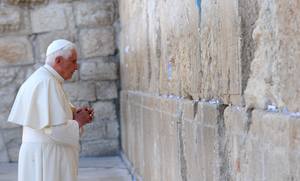
"A pilgrimage, indeed, the pilgrimage par excellence to the springs of faith, and at the same time a pastoral visit to the Church that lives in the Holy Land: a community of extraordinary importance, because it represents a living presence at the very place where it originated.”
These were the words of Benedict XVI on his return from his visit to the Holy Land. These words are also the essence of the Franciscan presence and of its mission to keep this community alive.
Benedict at the Grotto of the Annunciation in Nazareth
The visit of Benedict XVI to the Holy Land is charged with historical and spiritual importance.
The stages of the pilgrimage of "Peter" do not change, nor does the deep meaning of his speeches. His words for the Holy Land are words of support and encouragement for those seeking peace, for those seeking unity, and for those seeking the strength not to abandon it.
"The Church in the Holy Land, which has often experienced the dark mystery of Golgotha, must never cease to be an intrepid herald of the luminous message of hope that this empty tomb proclaims. The Gospel tells us that God can make all things new, that history does not necessarily repeat itself, that memories can be purified, that the bitter fruits of recrimination and hostility can be overcome, and that a future of justice, peace, prosperity and collaboration can arise for every man and woman, for the whole human family, and in a special way for the people who live in this land, which is so dear to the Savior’s heart.
This is how Benedict XVI encouraged those present who listen to him before the empty Tomb, the same one "that changed the history of humanity.”
This was, in short, a journey in the name of faith and hope.
Peace in the name of St. Francis
More than once the Supreme Pontiff thanked the friars of the Custody for their work in the Holy Land. He recognized the role of the friars as a necessary component to building peace, reminding everyone that St. Francis himself was a "great apostle of peace and reconciliation.”
Giuseppe Caffulli, Peter again at the empty Tomb, “Terrasanta” Magazine, Issue #3, May-June 2009, Year IV, pages 70-72 and Foreword, page 3.
«In this basilica, to which each and every Christian looks with profound veneration, the pilgrimage which I am undertaking together with my beloved brother in Christ, His Holiness Bartholomew, reaches its climax. It is an extraordinary grace to be here united in prayer. The empty Tomb is the place from where each year the good news of the Resurrection departs: «Do not be frightened! I know you are looking for Jesus, the crucified. He is not here. He is risen, as he had promised; come, see the place where he was laid. Hurry, and go to tell his disciples: ‘He is risen from the dead’» (Mt 28:5-7). This good news, confirmed by the witness of those to whom the Risen Lord appeared, is the heart of the Christian message, faithfully transmitted from one generation to another. It is the basis of the faith that binds us together, thanks to which we can together profess that Jesus Christ is only begotten Son of the Father and our only Lord.»
These are the words of the Pope during the meeting at the Holy Sepulchre.
Pope Francis had announced his visit in the Holy Land during the Angelus of 5 January 2014: “In the climate of joy, typical of this Christmas season, I wish to announce that from 24 to 26 May, God willing, I will go on a pilgrimage to the Holy Land to commemorate the historical meeting between Pope Paul VI and Patriarch Athenagoras I, which occurred exactly on 5 January of 50 years ago. The places I intend to visit are three: Amman, Bethlehem, Jerusalem. Three days. At the Holy Sepulchre we will celebrate an ecumenical meeting with all the representatives of the Christian Churches of Jerusalem, together with Patriarch Bartholomew of Constantinople».
Bethlehem
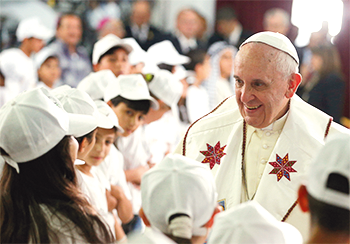
Bethlehem, 25 May 2014
«The Child Jesus, born in Bethlehem, is the sign that God gave to all those who awaited salvation. Today also, children are a sign. They are a sign of hope, a sign of life, but also a sign which helps us interpret and understand the state of health of a family, of a society, of the entire world. God repeats this sign also to us, men and women of the XXI century: «This for you will be a sign», look for a child...
Pope Francis precisely gave time and listened to Palestinian children, before leaving Bethlehem and Palestine. In the refugee camp of Dheisheh, the Pope met one hundred children, teaching them with some simple words how they can defuse hatred and violence and restart always anew in life: «Never think that the past determines your life. Look ahead always, work in order to acquire what you want. Violence is never won over by violence. Violence is won over by peace, by work, by dignity. I pray to God that He may bless you and I ask you to pray for me.
Ecumenical Celebration at the Holy Sepulchre
Jerusalem, 25 May 2014
In the same way in which, 50 years ago, Paul VI and Athenagoras embraced on the Mount of Olives, so Pope Francis and Patriarch Bartholomew met in the most significant place for every Christian: the Holy Sepulchre.
«It is with a sense of fear, emotion and respect – affirmed the Patriarch of Constantinople – that we are gathered here in front of “the place where the Lord lay”, the life-giving tomb from which life itself arose. We give thanks to the merciful God, who has made us worthy, we who are His unworthy servants, to receive the supreme blessing to become pilgrims in the place in which the mystery of salvation of the world has been revealed. This holy tomb invites us to stay away from another fear which is maybe more widespread in our modern era, namely, the fear of the other, of the one who is different from me, the fear from whoever adheres to another faith, to another religion, or to another confession. In front of this situation, the message that comes out of the tomb and which gives life is urgent and clear: to love the other, the other with his differences, the other who follows other faiths or confessions.»
The Pope declared: «Celebrating fifty years from the embrace of those two venerable Fathers, we recognise with gratitude and renewed sense of surprise how it was possible, under the driving force of the Holy Spirit, to make such important steps towards unity. We should continue to believe that, as the stone which covered the entrance to the tomb was rolled away, so all the obstacles which still hinder full communion between us can be placed aside. It will be a grace of resurrection, of which we can already have a taste today. Each time we ask for forgiveness to one another for the sins committed against other Christians, and each time we have the courage to give and to receive this forgiveness, we are making an experience of resurrection!»
The loving embrace of Jerusalem, in the sign of Pope Montini and Athenagoras, is now destined to touch the hearts of believers in the entire world.
Surprise visit in the convent of Saint Saviour
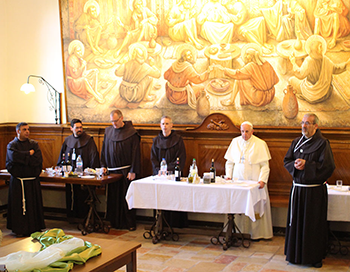
Jerusalem, 25 May 2014
Pope Francis, changing the official programme, had lunch with the Franciscans at Saint Saviour. No other Pope had done such a thing before, even though Saint Saviour is the central house of all the Franciscans of the Holy Land, and even though the Popes had celebrated in the Sanctuaries falling under the custody of the Sons of St. Francis. It has been a moment of intense joy. The applause of 95 brothers present in the refectory, many of whom are young, were heard in all Jerusalem. The lunch was very simple. We were able to experience the simplicity, the “minority”, as Pope Francis often repeated. In the photos, one can see the love of the Pope for all and also his simplicity and joy. What do you want me to tell you? For me it is as if a great friend as come to visit you. With him joy has also arrived. The Pope’s joy said it all. And I have felt myself more a Franciscan.
Synthesis of the text of Fr. Artemio Vítores, ofm
The Pope in Gethsemane: Who am I in front of my Lord who suffers?
Jerusalem, 26 May 2014
«In that hour, Jesus felt the need to pray and to have his disciples close to him, his friends who had followed him and had shared his mission more closely. But here, in Gethsemane, the following had become difficult and uncertain: doubt overtook the disciples, as well as fatigue and fear. In the inevitable succeeding moments of the Passion of Jesus, the disciples assumed different attitudes in front of their Master: attitudes of closeness, of physical distance, and of uncertainty. It would be a good thing for us all here, in this place, for us bishops, priests, consecrated persons, seminarians, to ask ourselves: who am I in front of my Lord who suffers? Am I one of those who, when invited by Jesus to watch with him, slept, and instead of praying tried to avoid problems by closing their eyes in front of reality? Or do I recognise myself among those who fled out of fear, abandoning the Master in the most tragic hour of his earthly life? Is there in me a double life, the false attitude of the one who sold him for thirty pieces of silver, who had been called a friend and yet had betrayed Jesus? Do I recognise myself in those who have been weak and have disowned him, like Peter?»
Before leaving Gethsemane, the Pope planted an olive tree in the garden of Gethsemane, as Paul VI had already done before him. It is an olive tree that will continue to narrate in the future centuries the hopes of peace and the witness of faith that Pope Francis wanted to sow with his presence on this earth.
The Pope in the Cenacle: here the Church was born, and it was born to go forth
Jerusalem, 26 May 2014
«It is a great gift that the Lord is giving us, namely that of gathering here in the Cenacle, to celebrate the Eucharist. Here, in this place where Jesus consumed the Last Supper with the Apostles; where, after he rose, he appeared in their midst; where the Holy Spirit came down with power on Mary and the disciples. Here the Church was born, and it was born to go forth. From here it went out, with the broken Bread in it hands, with the wounds of Jesus in its eyes, and with the Spirit of love in its heart.
The Cenacle reminds us of sharing, fraternity, harmony, and peace among ourselves. How much love, how much goodness has come out of the Cenacle! How much charity has issued from this place, as a river from its source, which in the beginning is a small stream, but then widens to become large... All the saints have drawn their richness from here; the great river of holiness of the Church always finds here its origin, its everlasting newness, from the Heart of Christ, from the Eucharist, from his Holy Spirit.
The Cenacle finally reminds us of the birth of the new family, the Church, our holy mother hierarchal Church, built by the Risen Christ. This is the horizon of the Cenacle: the horizon of the Risen Lord and of the Church. From here the Church has gone forth, full of life with the life-giving breath of the Spirit».


